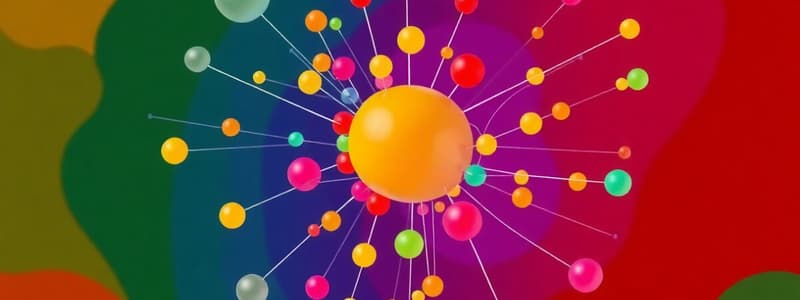Podcast
Questions and Answers
Which of the following scenarios would be most effectively studied using Agent-Based Modeling (ABM) due to its strengths in capturing heterogeneity and complex interactions?
Which of the following scenarios would be most effectively studied using Agent-Based Modeling (ABM) due to its strengths in capturing heterogeneity and complex interactions?
- Simulating the spread of a new virus in a population with varying immunity levels and social behaviors. (correct)
- Predicting the average annual rainfall in a specific region based on historical data.
- Determining the optimal inventory level for a single product in a stable market.
- Calculating the trajectory of a rocket in a vacuum.
In the context of Agent-Based Modeling, what is the most significant implication of 'emergence' for understanding complex systems?
In the context of Agent-Based Modeling, what is the most significant implication of 'emergence' for understanding complex systems?
- Emergence indicates that system-level patterns arise solely from the pre-programmed rules within individual agents.
- Emergence allows for precise prediction of system behavior based on initial conditions.
- Emergence suggests that unexpected system-level behaviors can arise from the interactions of individual agents, which cannot be predicted by examining the agents in isolation. (correct)
- Emergence confirms that complex systems are best understood by breaking them down into smaller, independent components.
Which of the following steps in building an Agent-Based Model (ABM) is MOST critical for ensuring the model's credibility and relevance to real-world phenomena?
Which of the following steps in building an Agent-Based Model (ABM) is MOST critical for ensuring the model's credibility and relevance to real-world phenomena?
- Defining agent attributes based on theoretical assumptions.
- Implementing complex interaction rules to capture intricate details.
- Creating a visually appealing simulation environment.
- Validating the model by comparing simulation results with empirical data. (correct)
How might incorporating social network analysis into an Agent-Based Model (ABM) enhance the understanding of information diffusion within a community?
How might incorporating social network analysis into an Agent-Based Model (ABM) enhance the understanding of information diffusion within a community?
In the context of ABM, what is the primary purpose of 'sensitivity analysis' during the model calibration process?
In the context of ABM, what is the primary purpose of 'sensitivity analysis' during the model calibration process?
Which of the following is a key advantage of using NetLogo for Agent-Based Modeling (ABM), particularly for beginners?
Which of the following is a key advantage of using NetLogo for Agent-Based Modeling (ABM), particularly for beginners?
When applying Agent-Based Modeling (ABM) to simulate a financial market, what aspect of agent behavior is MOST relevant for understanding market dynamics?
When applying Agent-Based Modeling (ABM) to simulate a financial market, what aspect of agent behavior is MOST relevant for understanding market dynamics?
In what way can Agent-Based Modeling (ABM) contribute to policy making, particularly in complex social systems?
In what way can Agent-Based Modeling (ABM) contribute to policy making, particularly in complex social systems?
Which of the following is a common mistake in Agent-Based Modeling that can significantly compromise the validity and usefulness of the model?
Which of the following is a common mistake in Agent-Based Modeling that can significantly compromise the validity and usefulness of the model?
When using Agent-Based Modeling (ABM) for modeling a supply chain, how would incorporating data assimilation techniques improve the accuracy and reliability of the simulation?
When using Agent-Based Modeling (ABM) for modeling a supply chain, how would incorporating data assimilation techniques improve the accuracy and reliability of the simulation?
Flashcards
Agent-based modeling (ABM)
Agent-based modeling (ABM)
A computational modeling approach where a system is modeled as a collection of autonomous decision-making entities called agents.
Agents
Agents
Independent entities within an ABM that have their own states, behaviors, and decision-making rules.
Environment
Environment
The space in which agents exist and interact within an ABM, providing a context for their actions.
Interactions
Interactions
Signup and view all the flashcards
Rules
Rules
Signup and view all the flashcards
Emergence
Emergence
Signup and view all the flashcards
State Variables
State Variables
Signup and view all the flashcards
Decision Rules
Decision Rules
Signup and view all the flashcards
Parameter Estimation
Parameter Estimation
Signup and view all the flashcards
Model Validation
Model Validation
Signup and view all the flashcards
Study Notes
The provided text includes the same information as the existing notes. As such, there is no new information to add or changes to be made.
Studying That Suits You
Use AI to generate personalized quizzes and flashcards to suit your learning preferences.



